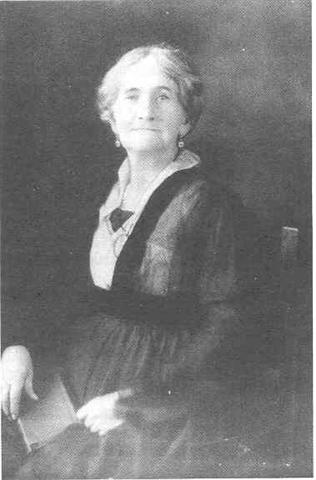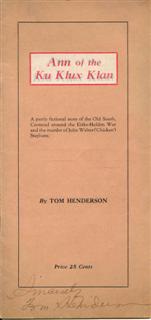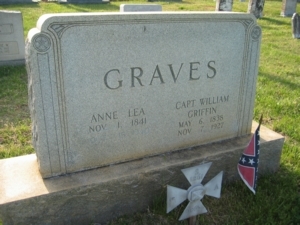
- Born 1 November 1841 in Caswell County
- Lived Almost 100 Years
- Died 15 October 1940 in Virginia
- Subject of Ann of the Ku Klux Klan

|
|
Caswell County historian William S. Powell made the following observations on the Ku Klux Klan in When the Past Refused to Die: A History of Caswell County North Carolina 1777-1977, William S. Powell (1977) at 234-235:Ann Lea was the daughter of Thomas Lea and Ann Blount Wright of Virginia. She was born November 1, 1841 in Caswell County, N.C. and died October 15, 1940 at the home of her daughter, Brandon-on-Dan in Virginia just before her 100th birthday.
Ann was the only daughter in a family of eleven children.
An interesting story regarding Ann Lea stated that while on her way to her uncle's, Dr. Calvin Graves'1 home, Ann went down to a cave on Country Line Creek and witnessed a meeting of the Ku Klux Klan. She was discovered and was given the oath of allegiance to join the Klan as she had overheard their discussion of Senator "Chicken" Stephens. After joining the Klan, Ann was to take part in sewing robes for the members and kept them hid [sic] under the parlor rug when not in use.
During the term of Governor W.W. Holden, many men from Caswell were arrested and held as prisoners as the county was in a state of turmoil following the Civil War. Among those arrested was Ann's husband, Capt. Billie Griffin Graves. During this time Ann was left at home with two small children. "Liney", a faithful ex-slave stayed with Ann and was her confidante. Liney's husband, Jeff McGhee also stayed on the plantation. After the impeachment of Governor Holden, however, the days became more peaceful in Caswell County.
Here are some quotes from Ann Lea regarding her life:
I was almost twenty years old when the War Between the States commenced, I had been educated in all the feminine arts of that day and time, yet I was ever a tomboy, pals to my brothers, and riding and hunting and roughing it with them. I was a student of Rev. Solomon Lea's School for Girls at Leasburg and an alumna of Greensboro Female College, under its first president, Rev. Lea. It was of my musically sweet voice that Governor John Motley Moorehead, coming to speak at one of the college's first commencements, said that the notes sounded too angelic to come from the throat of a human being.
It was at Leahurst2 that Captain Billie Griffin Graves wooed and won my heart, after he had been freed from a Yankee prison. It was there, also, that I, when word came of the coming of the Yanks, gathered the most valued possessions of the home and sewed them in the stuffing of the "love seats". Then, with the help of faithful slaves, I hitched the handsome carriage horses, Remus and Romulus, to the fine carriage which my father, Thomas Lea, had purchased in Richmond. I myself drove the conveyance, with the "love seats", the family silver and other heirlooms, to Ivy Banks3 and hid my cargo in the cave until danger had passed.
Terrorism reached a peak in Alamance and Caswell counties after the fall elections in 1868, when it was discovered that they were among the few counties in the state in which Republicans had gained strength. Clearly if Conservatives were to return to power at the 1870 election, desperate action was necessary. Initially the Klan may have been organized by young men in Caswell "as a lark, for fun," as one resident later recalls, but it soon came to have more serious purposes. Captain John G. Lea, unidentified at the time of course, was head of the Klan in Caswell County. Ann, his sister sewed the uniforms for the Klansmen, she later reported and was privy to all of their secrets. It was at their home, Leahurst, that the robes were hidden and that the Klansmen gathered whenever there were duties to perform. . . .

(Click Photograph for Larger Image)
|
Yanceyville writer Tom Henderson captured the story of the relationship between Ann Wright Lea and the Ku Klux Klan in his little booklet Ann of the Ku Klux Klan. Here is the final chapter:
|
(Author's note: Much of the history of Caswell County for nearly 50 years was centered around the Kirke-Holden war and the Ku Klux Klan murder of John Walter ('Chicken') Stephens. There have been many garbled accounts of this history printed, which did injustice to the klan and infamed the name of the murdered politician. Many people have asked me to write the story. I have done it without prejudice and without intention of offending or injuring. The foundations of the story are truthful, in so far as records and reminiscences can be relied on, howbeit I have drawn on my imagination in fictional style. Aside from the standpoint of "reader interest," I have had two purposes in view. One is to show the justification of the existence of the Ku Klux Klan at a time when our courts of justice had broken down. The other is to show that Stephens was not as bad as he has been painted. 'Squire Thomas S. Harrison and John Marshal Wooding were no fools when they refused to accept from Governor Holden the commission which John Walter Stephens did take.
My sincere appreciation is herewith expressed to the advertisers5 who made it possible for me to publish this booklet. My thanks are also given to the editor and his force of 'The Caswell Messenger' for their helpfulness. All rights in this story are reserved.)
After Ann Wright Lea married William Griffin (Billy Griffin) Graves, they lived just west of Leahurst and west of Route 62 (Yanceyville-Milton Road) near Rattlesnake Creek. The home was built around 1840 by General William Lea (born c. 1802), an Uncle of William Griffin Graves. In the 1850 US Census the nephew was residing with his Aunt Elizabeth and Uncle William Lea, who had no children. After the death of William Griffin Graves the home was sold to Thomas Oldham Jones (1859-1902). The house is believed to be in ruins today.
Photo 165. Leahurst. Ca. 1840 Boom Era type Greek Revival 2-story frame house with exterior end brick chimneys, double door entrance. Pedimented Doric entrance porch with interesting applied wooden shell motif in relief on the tympanum. According to local tradition this was where the Caswell County Ku Klux Klan chapter was organized and functioned as the place of robing. |

|
